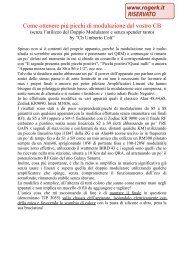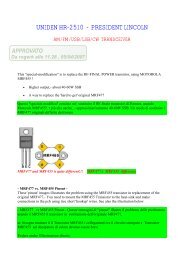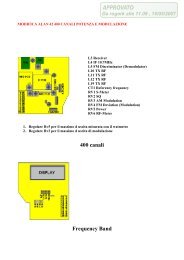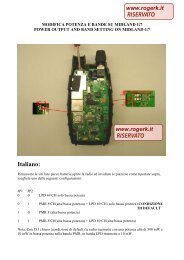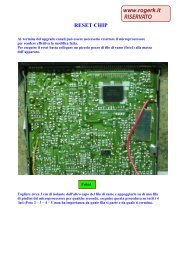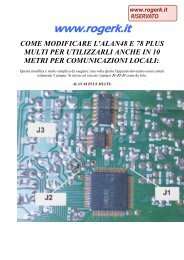Modifications for the ICOM - RogerK
Modifications for the ICOM - RogerK
Modifications for the ICOM - RogerK
- No tags were found...
Create successful ePaper yourself
Turn your PDF publications into a flip-book with our unique Google optimized e-Paper software.
19-07-1998(IC-751) IC-751 Bad Cap ProblemsThis info may be helpful to <strong>ICOM</strong>-751 owners with units approaching five years of many operating hours; two UNRELATEDproblems occurred, both due to a similar 10uf electrolytic opening up. The first was <strong>the</strong> input cap.to <strong>the</strong> 5-volt regulater chip which supplies PLL board. Proper by-passing is required, probably to prevent internal oscillations in<strong>the</strong> chip.Replaced it with a tantulum. (Also arbitrarily replaced electrolytic on <strong>the</strong> output side of <strong>the</strong> 5-volt reg. chip). The symptoms were3 or 4 minutes delay be<strong>for</strong>e unit would function. Also <strong>the</strong> screw holding <strong>the</strong> reg-chip to its heat-sink was a little loose...probablydue to COLD-FLOW characteristics of aluminum. This can also occur in pheof aluminum. This can also occur in phenolic P-Cboards where <strong>the</strong> groundfoil is supposed to be bolted tightly to <strong>the</strong> chassis. It would probably be a good idea to use small splitringlock-washers (along with flat-washers) in <strong>the</strong>se cases to maintain tension over time.The second malfunction was failure of <strong>the</strong> display digits etc to appear until a warm-up time of perhaps 10 minutes or more (afterwhich you must power-down up to generate a new reset-pulse). It also turned out to be an open 10uf electrolytic on <strong>the</strong> -5voltline which supplies IC-1 IC-2 on <strong>the</strong> Display Unit Board. This board attaches to <strong>the</strong> front assembly near <strong>the</strong> displaydigits...parallel to <strong>the</strong> floor. The front assembly DOES unscrew with 4 screws and move <strong>for</strong>ward an inch or two, but this isactually not necessary. The board has a 3-position connector attaching, but only <strong>the</strong> two outside ones have wires....red is 13.8voutside ones have wires....red is 13.8v dc input, and purple is -5v output.The purple (-5v) wire, but ra<strong>the</strong>r is on <strong>the</strong> opposite side of <strong>the</strong> inductor (L1) which does connect to <strong>the</strong> purple wire. A -5v zenerto-groundappears here, and <strong>the</strong> culprit 10uf is directly in parallel across <strong>the</strong> zener. I didn't have a 10uf tantulum handy but a39uf did <strong>the</strong> job. I also arbitrarily shunted C-17 (easily visible) with a 33uf tantulum, and C-25 which is ano<strong>the</strong>r 10uf (easilyvisible) was shunted with a 2.2uf tantulum. (Tack-soldered on foil-side).I didn't have a 10uf tantulum handy but a 39uf did <strong>the</strong> job. I also arbitrarily shunted C-17 (easily visible) with a 33uf tantulum,and C-25 which is ano<strong>the</strong>r 10uf (easily visible) was shunted with a 2.2uf tantulum.(Tack-soldered on foil-side).With such a trend developing...it would appear that if you are experiencing o<strong>the</strong>r kinds of malfunctions, open electrolytics mightbe under suspicion....it should not be necessary to remove <strong>the</strong>m in most cases...just tack-solder a tantulum in parallel on <strong>the</strong> foil-side.This modification is read 1246 times.top of page19-07-1998(IC-751) General coverage mod <strong>for</strong> <strong>the</strong> <strong>ICOM</strong> IC-751A1. Remove top and bottom covers from rig.2. Remove cover <strong>for</strong> RF unit (left side).3. Locate J2 near center of RF board (multi-pin connector).4. Clip brown wire (pin 1). Maybe <strong>the</strong> wire is black5. Rig will now transmit in Gen. Cov. mode above 1600 khz.This modification is read 1467 times.top of page19-07-1998(IC-751) IC-751 Switch MatrixThis following chart was generated by shorting out <strong>the</strong> matrix points and watching <strong>the</strong> function that is per<strong>for</strong>med. Some areintuitive already from <strong>the</strong> schematic. There are only a couple of "extra" functions in <strong>the</strong> matrix (ie, USB and LSB, Reset 100&10Hz [The TS switch does this as well]). The KEY? GENE switches (Y0) are accessed by <strong>the</strong> RC-10 controller, but I noticed thatsome "removed" circuitry in <strong>the</strong> rig was designed to switch <strong>the</strong> digit switches on <strong>the</strong> RC-10 controller to <strong>the</strong> KEY? HAM array(Y3), effectively making <strong>the</strong> switches directly access each band. However, <strong>the</strong> removed circuitry (a set of switching transistors) isreplaced by a solid jumper to Y0 :-(. The "empty" slots in <strong>the</strong> following table showed no perceivable function.The Y5 matrix, acted like it was shorting some o<strong>the</strong>r behavior out causing <strong>the</strong> rig to switch to <strong>the</strong> specific memory channels (youcan observe a binary + 1 selecting behavior) temporarily.Have fun, Ciao, 73 de VE6MGS/Mark -sk-IC-751A Switch Matrix (W/ Function)




